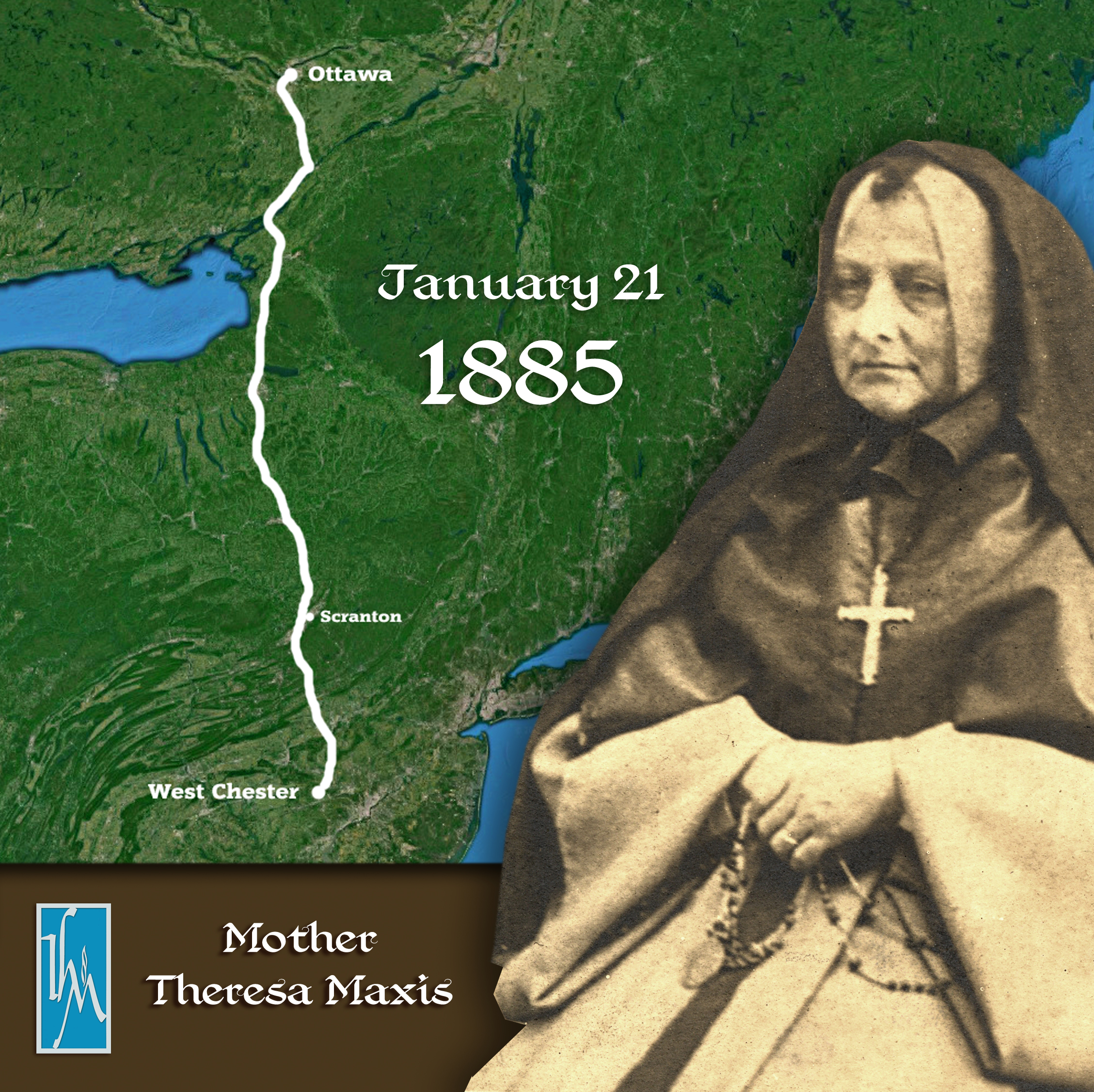
January—A Month for Going Home
by Margaret Gannon, IHM
There was probably never a January before this one that we welcomed so enthusiastically. We see this January as the early dawn of a new, much happier year.
January was a very significant month for Mother Theresa Maxis Duchemin. It was the month for going home—three times.
Theresa’s long-term exile from the Congregation began in January 1869, when she returned to the Grey Nuns in Ottawa. She and Sister Celestine, who was the charter member of the Congregation, and Theresa Renault, had stayed with the Grey Nuns for some months in 1868. Theresa had attempted to return to the Congregation in Monroe, Michigan in September 1868. She and Sister Celestine approached Bishop Lefevère and asked to be returned. The Bishop re-admitted Sister Celestine but refused Theresa. Traveling east to Pennsylvania, Theresa was refused re-admission there. She went back to her hometown of Baltimore.
Finding no home there, she wrote to Mother Elizabeth Bruyère, the superior of the Ottawa Grey Nuns. “Here I am then, an outcast neither more nor less.... I have, as a last recourse, obtained hospitality in this orphanage for a few days only, and I do not know where to go.” Mother Elizabeth generously invited Theresa to return and Theresa arrived in Ottawa on January 7, 1869; it was a going home of sorts, at a moment when Theresa had nowhere else to go.
In the first six years of Theresa’s exile, the Scranton bishop forbade the sisters’ communication with Theresa except for a Christmas card from Sister Ann, her companion from the beginning of the Congregation. (Charlotte Schaaf). Beginning in 1885, Sister Genevieve Morrissey, assistant to the Scranton superior general, began a correspondence that lasted until the end of Theresa’s exile.
Theresa’s letters are historical treasures preserved in the Scranton IHM archives. They reveal much about Mother Theresa, especially how eager she was to be reunited with her sisters. She offered numerous strategies for persuading or eluding the bishops’ power. Perhaps the most remarkable was the following strategy: “I felt badly on hearing about dear Holy Sister Agatha’s sickness. I always thought I would see her before dying. I will tell you a thought I had though it may be foolish. Since she is expected to die soon, I thought if she expressed a desire of seeing me, that perhaps Bishop O’Hara would permit me to go.”
A number of persons worked to bring about Mother Theresa’s return. Many of her Redemptorist friends continued to take an interest in her situation, but the most diligent was Rev. Francis Schnüttgen, CSsR. He led the effort to appeal with the new Archbishop of Philadelphia, Patrick J. Ryan, to welcome Theresa back to the congregation. Bishop Duhumal of Ottawa also lent his support to the effort. At the same time, the Immaculata IHMs undertook to facilitate her return. Most instrumental was the Superior General, Mother Gonzaga Rooney. This was ironic because Theresa had believed that Mother Gonzaga was one of the opponents of her return. That suspicion disappeared totally when Theresa learned of the extensive efforts Mother Gonzaga had invested in Theresa’s return.
Mother Francis Henry, the superior general of the Scranton IHMs, worked devotedly to persuade Bishop O’Hara to allow Mother Theresa to return to the Scranton congregation. But the bishop refused, since it was Bishop Wood, not he, who had granted Theresa’s dispensation. By 1885, Bishop Wood had died and a new Archbishop had come into office, Patrick John Ryan.
Father Schnüttgen and Bishop Duhamel both interceded with archbishop Ryan. The Archbishop saw no problem in Theresa’s return and arrangements began to be made. In response to Mother Gonzaga’s announcement, Theresa greeted her with joy and gratitude. “How incomprehensible are the ways of God! How great the power of prayer! Words are inadequate to express my feelings! My poor heart is full to overflowing!”
Mother Theresa’s dream of reuniting with her IHM sisters came to fulfillment at the West Chester Motherhouse on January 21, 1885. One of the first sisters to great her was her faithful friend Sister Ann. Theresa described the celebrations to Sister Genevieve: “Words are inadequate to express my joy and grateful feelings to Our Dear Lord for his great mercies in restoring me again to my own. I am so happy in being in the Institution, so dear to me and which I never left at heart, indeed, we have been here in jubilation, ever since my arrival.” This was her second January going home.
One difficulty that dampened Theresa’s joy was the mandate of Scranton’s Bishop O’Hara forbidding Theresa from visiting the Scranton diocese. In 1871, he had separated the IHMs living in the Scranton diocese into a separate congregation. Thus, Theresa was cut off from a sizable portion of the original congregation. The Scranton sisters were also forbidden to write regularly to Theresa.
Theresa lived happily at the West Chester Motherhouse for seven years. During those years she shared with the sisters her life story, including her participation in the Baltimore African-American society and culture, and her “passing” into the white society when she moved to Michigan in 1845.
Theresa died from complications of influenza on January 14, 1892. Her sisters were with her at her deathbed and she joined in the prayers to the end. She then departed—on her final January journey of going home.